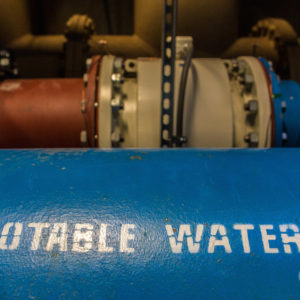Federal Water Tap, October 28: WOTUS Rule Gone As Trump Administration Finalizes Repeal
The Rundown
The EPA finalizes a repeal of the Obama administration’s definition of the scope of the Clean Water Act. The EPA also selects 38 water infrastructure projects to apply for $6 billion in low-interest loans and decides to cut two expert advisory committees. Fisheries agencies claim that changes in operations to a federal water delivery system in California will not harm endangered species. Bills in the House and Senate seek to establish water affordability pilot programs. A bill to authorize federal involvement in construction of a Montana rural water system advances in the Senate. The GAO creates a disaster resilience framework for the federal government. Senators announce a climate solutions caucus. USGS researchers use tree-ring data to reconstruct more than 11 centuries of Missouri River flows. And lastly, USAID invests in small businesses working in water, food, and energy.
“We’re looking for solutions. We’re looking for solutions that come from anywhere. We recognize that we do not have a monopoly on the good solutions. We don’t even very often have a clue about the good solutions. There are great solutions that are generated everywhere on earth. And the idea behind a grand challenge is to give those great ideas a platform. We’re going to encourage organizations, individuals to submit to us concept papers about how you would visualize a solution to the problems that we see around the world, or in an individual country, that are at the nexus of water, energy and food.” — Bonnie Glick, deputy administrator of the U.S. Agency for International Development, discussing a new food security initiative that focuses on women and linkages to energy and water. Glick announced $35 million in funding for the Water and Energy for Food Initiative. A USAID spokesperson told Circle of Blue that the money will be invested in “regional innovation hubs” that will provide grants and technical assistance to small businesses involved in water, food, and energy.
By the Numbers
38: Water, sewer, and stormwater projects invited to apply for low-interest federal loans. Combined, the loans will total $6 billion. This marks the third round of funding for the WIFIA loan program. (U.S. Environmental Protection Agency)
$183 billion: Disaster funding approved by Congress in the last three years in response to fires, floods, droughts, and other natural hazards. (Government Accountability Office)
News Briefs
WOTUS Repeal
The EPA and Army Corps of Engineers finalized their repeal of the Obama administration’s definition of the scope of the Clean Water Act.
The agencies claimed that the rule exceeded their legal authority and took too much power away from the states. They also claimed insufficient support for using distances from streams to mark the boundaries of the law’s jurisdiction.
Fights over this decision are just beginning. The agencies were promptly sued by 11 environmental groups, which alleged that the administration did not follow proper procedures in its repeal, in essence prejudging the outcome and not taking public comments into account.
In a separate process, the agencies are working on their own, more restrictive definition of which waterways qualify for protection.
Water Affordability Bills
A bipartisan group of lawmakers introduced bills in the House and Senate to test-run water affordability programs for poor families.
The Low-Income Water Customer Assistance Programs Act authorizes the EPA to give grants to 32 public water systems to establish pilot programs to reduce the cost of drinking water service. It authorizes an additional 32 programs for wastewater service.
The bill does not outline requirements for the pilot programs. Instead, it gives the EPA two years to work out what sorts of financial assistance are acceptable.
The number of grants are evenly divided between large, medium, and small communities, but preference is given to those with large recent rate increases.
The bill also requires the EPA to submit a report on the number of households that do not have centralized sewer service or a functioning on-site system.
Rep. Marcia Fudge (D-OH), one of the co-sponsors, introduced a similar bill in the House in 2016 that did not pass.
In context: When It Comes To Water Service, How Expensive Is Too Expensive?
Water Infrastructure Grant Bill
A bipartisan bill was introduced in the Senate to provide grants to small public water systems for maintenance and repairs.
The Assuring Quality Water Infrastructure Act offers a small sum, only $5 million per year over five years. In comparison, the U.S Department of Agriculture’s Rural Utilities Service had $400 million in grant funding in fiscal year 2019 for its water, sewer, stormwater, and solid waste disposal program.
In context: Aging Sewer System Imperils North Carolina Town’s Finances
Rural Water Bill Advances
A bill to authorize a rural water system in central Montana moved out of a Senate committee.
The bill from Sen. John Tester (D-MT) authorizes the federal government to pay up to 65 percent of the cost of the Musselshell-Judith water system. Based on cost estimates, that amounts to $56 million.
Congress has authorized a number of rural water systems, but it has not provided the funds to build them in a timely manner, according to Bureau of Reclamation testimony, which noted in June a $1.3 billion backlog in authorized projects.
“Authorizing additional rural water projects may delay completion of rural water projects that are already under construction,” said Grayford Payne, deputy commissioner of policy, administration, and budget at the Bureau of Reclamation.
Advisory Committees Cut
In response to an executive order, the EPA will eliminate two expert committees that advise the agency on laboratory testing and technology policy, E&E News reports.
In June, President Trump ordered federal agencies to reduce the number of expert advisory committees.
The two committees that the EPA will cut are the Environmental Laboratory Advisory Board, which has been involved in drinking water testing, and the National Advisory Council for Environmental Policy and Technology.
Senate Climate Caucus
Senators looking for a place to find common ground for climate action now have an official talking shop.
Sens. Mike Braun (R-IN) and Chris Coons (D-DE) announced the Senate Climate Solutions Caucus, a forum for developing bipartisan legislation. The group has a lofty goal: “to take the politics out of this important issue.”
A similar group in the House was restarted earlier this year following an election in which many Republican members, including the co-founder, Carlos Curbelo of Florida, lost their seats.
Studies and Reports
California Water and Fish
The U.S. Fish and Wildlife Service and the National Marine Fisheries Service claim in separate assessments that the operation of a federal water delivery system in California will not harm endangered fish species.
Farm interests cheered the flexibility in the proposed rules, while environmental groups criticized the changes as damaging to already distressed fish populations and contradictory to preliminary findings from federal biologists.
EPA’s Hurricane Harvey Response
The EPA adequately managed funding in response to Hurricane Harvey, according to an audit by the agency’s inspector general.
After the storm, Federal Emergency Management Agency officials tasked EPA staff with identifying and cleaning up releases of hazardous materials and monitoring air and water quality. The audit found that the agency learned from past mistakes in contracting and is doing post-event evaluations to pinpoint ways to improve.
Missouri River Flows, Reconstructed
U.S. Geological Survey researchers contributed to a study that used tree-ring data to build a historical record of Missouri River flows dating back more than 11 centuries.
The study found considerable variation over the centuries.
Flow reconstructions like these show natural variability over a much longer time period than direct measurements, which, for the Missouri River, have been taken for little more than a century.
Disaster Resilience
The Government Accountability Office developed a framework to guide federal agency responses to disaster preparation.
The framework encompasses three principles: accurate information about current and future risk, integration of plans across agencies and sectors, and incentives that align federal programs with local needs to reduce risk.
On the Radar
Congressional Hearings
On October 30, the Senate Energy and Natural Resources Committee meets to learn about technological solutions for water scarcity in the American West.
Also on October 30, the House Select Committee on the Climate Crisis will discuss ways agriculture can be part of a low-carbon future.
Aquatic Invasive Species Meeting
The Aquatic Nuisance Species Task Force, a federal and nongovernmental forum, is scheduled to meet on November 6 and 7 in Beltsville, Maryland. The agenda for the public meeting includes: ballast water, noxious weeds, quagga and zebra mussels action plan, and using genetic manipulation to control unwanted species.
Federal Water Tap is a weekly digest spotting trends in U.S. government water policy. To get more water news, follow Circle of Blue on Twitter and sign up for our newsletter.
Brett writes about agriculture, energy, infrastructure, and the politics and economics of water in the United States. He also writes the Federal Water Tap, Circle of Blue’s weekly digest of U.S. government water news. He is the winner of two Society of Environmental Journalists reporting awards, one of the top honors in American environmental journalism: first place for explanatory reporting for a series on septic system pollution in the United States(2016) and third place for beat reporting in a small market (2014). He received the Sierra Club’s Distinguished Service Award in 2018. Brett lives in Seattle, where he hikes the mountains and bakes pies. Contact Brett Walton






Leave a Reply
Want to join the discussion?Feel free to contribute!